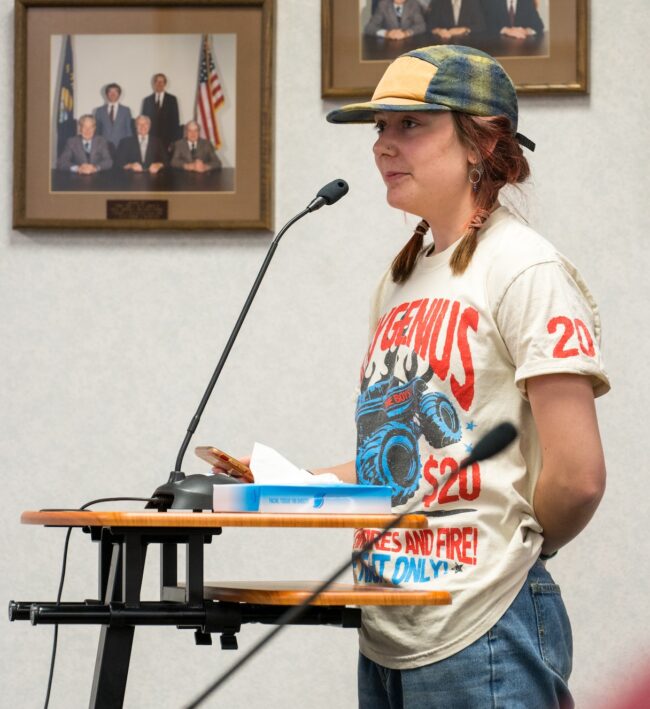By Nick Fitzmaurice

A high school student gives comment at a PSC meeting in February. If NorthWestern gets its way, the public will lose its ability to participate in the development of NorthWestern’s plan. Photo by Floating Leaf Studios.
In 2023, NorthWestern Energy published a wholly insufficient Integrated Resource Plan (IRP) with incomplete data and skewed modeling results supporting the utility’s expensive and environmentally damaging fossil fuel investments. Montana law requires NorthWestern to develop an IRP every three years, outlining how the utility intends to meet customer energy demands over the upcoming 20 years. Unfortunately, as the utility enters its next planning cycle, it once again neglects to engage in a transparent and rigorous process, violating statutory and administrative requirements while shirking its obligation to address the public’s concerns for reliability and affordability.
Montana’s Integrated Least-Cost Resource Planning & Acquisition Act requires “a broad-based advisory committee to review, evaluate, and make recommendations on technical, economic, and policy issues related to a utility’s electricity system.” The Electric Technical Advisory Committee (ETAC) is an essential tool for guiding the IRP development process, which is why it’s concerning that NorthWestern quietly established its current ETAC at the end of 2023 with a small membership of almost exclusively government and NorthWestern-funded entities. It then proceeded to hold its first three meetings closed to the public. The utility has not satisfied the basic statutory requirement for this committee to be “broad-based” and has violated its legal obligation to make these meetings open to the public by holding these meetings in secret. In closing its technical advisory committee to the public, NorthWestern is an extreme outlier among other utilities in the region.
In the past, NorthWestern’s ETAC has consisted of a large, broad pool of unbiased, independent organizational representatives. Many had served on this committee for years or decades and are now notably excluded. They had historically gone to bat repeatedly to keep ETAC meetings open to the public and argue for affordable and reliable electric system planning. ETAC now lacks representation from large and small-scale energy developers, low and fixed-income customer advocates, independent economists, Montana-based NGOs like MEIC, and qualified members of the public. Residential customers — NorthWestern’s only customer class showing substantial growth and arguably NorthWestern’s largest stakeholder — are not specifically represented.
When asked about ETAC at the legislative Energy and Telecommunications Interim Committee meeting in July, NorthWestern’s representative provided an ambiguous response. He neglected to mention that a new, limited ETAC committee had already met three times and that the utility had taken down its ETAC website while failing to notify the public or the legislature about the meetings, which are required by law to be open to the public. Meanwhile, NorthWestern is working behind the scenes to eliminate ETAC from statute altogether in the upcoming legislative session, further jeopardizing transparency and public trust in the IRP process. MEIC will not stand for this.
MEIC brought these concerns to the Public Service Commission (PSC) in July, which promptly responded with a letter to NorthWestern reaffirming MEIC’s concerns and requesting the utility explain its current ETAC process and reconcile its actions with Montana law and Commission rules. NorthWestern’s response was defensive and unapologetic, though the utility brought its ETAC webpage back online and asserted that its next ETAC meeting would be open to the public – though the public could only participate remotely with no opportunity to comment. While ETAC membership remains far from broad-based, MEIC advocacy at the PSC and legislature are ongoing to keep these meetings public and guarantee more transparency and broad-based representation in these meetings. Unbiased experts must have access to ETAC to ensure that the utility’s next 20-year plan employs sound modeling to fairly represent Montana’s clean, affordable, and reliable energy potential.
This article was published in the October 2024 issue of Down To Earth.

